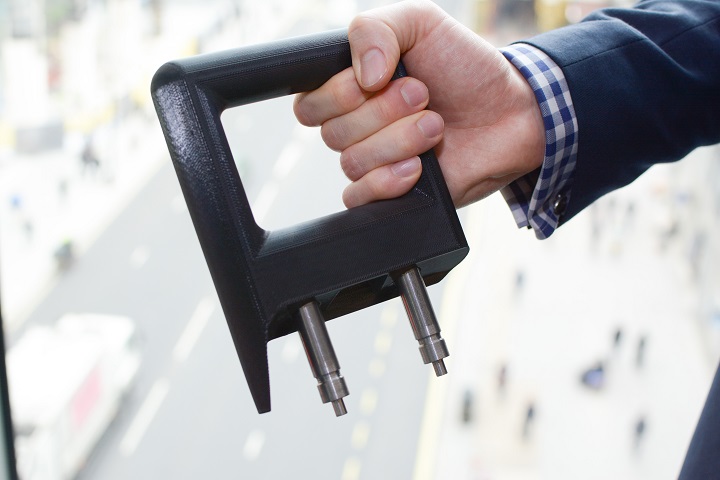![3D printed rail grab handle [Image: Stratasys]](https://fabbaloo.com/wp-content/uploads/2020/05/DSC_3294_img_5eb0a0fc73517.jpg)
As 3D printing continues to come into play for on-demand and spare parts manufacture, a new collaboration targets the UK rail industry.
Trains have been proving an application area of increasing interest for 3D printing — and for Stratasys. The company recently teamed up with Siemens Mobility to install a Fortus 450mc in their RRX Rail Service Center in Dortmund-Eving, and today has announced a new collaboration in the UK.
Train leasing company Angel Trains, engineering consultancy ESG Rail, and Stratasys are coming together for the redesign and fabrication of electrical connection covers, an arm rest, a grab handle, and a seat back table for service use in passenger trains.
“With the highest level of repeatability in the industry and advanced, rail-certified, materials, we believe our FDM additive manufacturing solutions offer huge potential to replace traditional manufacturing for a diverse range of applications within the rail industry,” said Yann Rageul, Manager, Strategic Account Team EMEA, Stratasys. “This collaboration will help us to explore how we can support rail companies, such as Angel Trains, to produce parts on-demand – both cost-effectively and efficiently – eradicating the need for obsolete inventory and improving their ability to service customers.”
ESG Rail has structurally assessed all components, which have been tested for adherence to Rail Standard EN45545-2, and in-service trials are set to begin soon and run until summer 2019.
![FDM 3D printed parts (left to right): electrical connection covers, grab handle, arm rest, seat back table [Image: Stratasys]](https://fabbaloo.com/wp-content/uploads/2020/05/image-asset_img_5eb0a0fcdd0f7.jpg)
The parts are created using high-performance materials including PEKK-based Antero 800NA on Stratasys’ FDM systems.
“We have learned so much during this project and have addressed many engineering challenges. We believe that this emerging method of manufacturing will reduce costs, production times and issues faced by component obsolescence,” Martin Stevens, Head of Mechanical Engineering, ESG Rail, said.
Proving out additive manufacturing as a solution for spare and replacement parts is leading to a stronger future for digital inventory solutions as obsolescence can itself become obsolete. 3D printing parts to exact specifications with qualified materials and systems enables a more agile supply chain and production workflow.
This particular collaborative effort aims “to leverage additive manufacturing to help address the issue of obsolete parts, reduce whole life rolling stock costs and enable vehicles to remain in passenger service for longer,” the announcement notes. A key benefit of additive manufacturing coming into play here is in low-volume manufacturing, as the train operating companies don’t have to mass manufacture parts, via traditional technologies, that might then just go on to sit on warehouse shelves for years until (and if) needed.
The need to redesign the four components targeted for 3D printing also highlights the importance of design for additive manufacturing (DfAM) as a growing need in an upskilling manufacturing industry.
Railway applications for 3D printing are continuing to pick up, particularly in Europe, and this collaboration represents a first for that industry in the UK.
“This exciting industry-first collaboration has the potential to transform manufacturing within the rail industry,” said Mark Hicks, Angel Trains’ Technical Director. “We are proud to be driving this innovation with ESG Rail and Stratasys and hope that this solution will help to free the industry from technological constraints, and allow our trains to continue to meet passengers’ needs now and in the future.”
Via Stratasys

